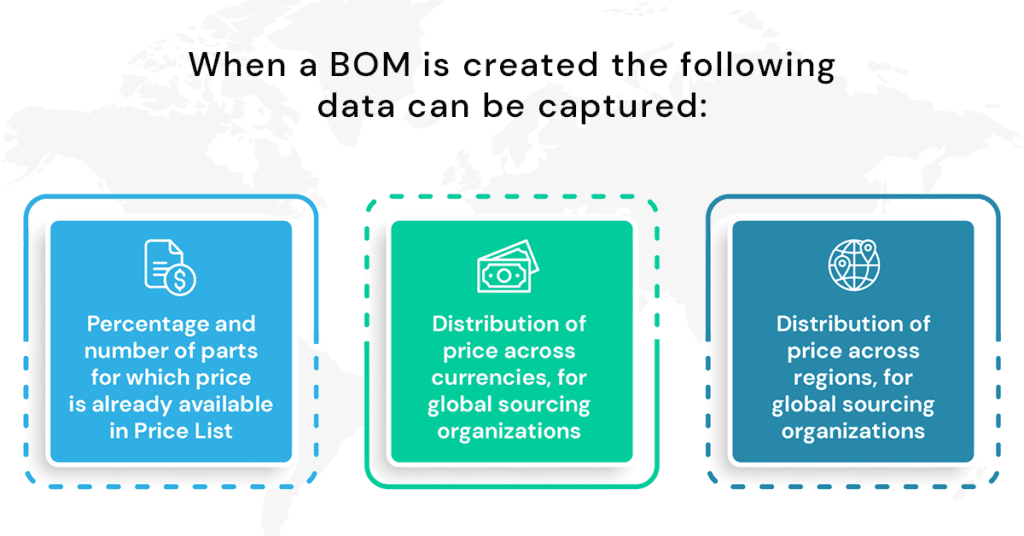Analytics is a key component of any data-intensive business process. Sourcing and procurement is centered around spend, savings, suppliers, and categories and it relies heavily on insights and in-depth analytics from the right data to make business decisions. The ability to cull out meaningful insights from sourcing and procurement data, act on them and generate prescriptions for improved bottom-line and topline can lift sourcing organizations to the next orbit in terms of evolution. It helps in determining the best suppliers to work with, negotiating prices, managing spend and so on. According to a recent Deloitte Global Chief Procurement Officer Survey 2021, 91.67% of “high performing” procurement teams assess their capacity to realize cost reductions more than any other KPI and analytics represents the first move towards creating a more efficient procurement organization. Especially, when it comes to direct material sourcing, analytics plays a crucial role in allowing manufacturers to optimize costs, uncover supply risks and accelerate New Product Development (NPD) or New Product Introduction (NPI). In this blog, we will discuss how manufacturers can leverage direct material sourcing analytics in detail.
Typically, sourcing organizations center their analytics around Spend, Savings, Suppliers, Categories, etc. In addition to all of these standard sourcing analytics targets, direct material sourcing organizations can be benefitted by looking at some of the key aspects like BoM analytics and Should-be-price or Should-Cost analytics. These insights can help you focus on the right opportunities – for faster and more cost-efficient acquisition of materials, and ultimately deliver more value to the organization.
Table of Contents
ToggleBoM Analytics
Your Bill of Materials carries a gold mine of data and direct sourcing organizations can be hugely benefitted by analyzing them. You can analyze the BoM and get insights around cost impact for different versions of BoM to arrive at optimal decisions on suppliers, parts, etc. for price and design effectiveness.
BoM Price Analysis
Whenever a new BoM or a new version of an existing BoM is created because of a new product design, by comparing the parts of the BoM against the existing Price List, the following data can be captured:
- Percentage and number of parts for which price is already available in Price List
- Distribution of price across currencies, for global sourcing organizations
- Distribution of price across regions, for global sourcing organizations

These insights will bring about the estimated sourcing price of the BoM to the extent of price list available, the possible impact of currency fluctuations, regional distribution of suppliers, etc.
Similar Parts Analysis
New Product Development (NPD) or New Product Introduction looks at and generates BoM from the perspective of design effectiveness alone. Once it reaches Sourcing, there is an opportunity for direct sourcing systems to look at BoM from the perspective of price effectiveness. Similar parts analysislooks at attributes of the parts and searches the price list to see if there are alternative parts with comparable attributes but better prices and make suggestions to the NPD team in Product Development/Product Engineering or R&D for the possibility of replacing them.
Sourcing and NPD can collaborate to arrive at the most optimal BoM from the perspectives of design and price.
Should-Be Price Analytics or Should-Cost Analytics
It is always a good practice to commence sourcing events with a target price of parts being sourced. It gives a clear picture for comparing quotes. However, setting a target price is a tricky affair with ever-changing requirements and design.
With a clear understanding of the raw materials and manufacturing process of the parts involved, competent sourcing professionals can estimate the should-be price of the new parts with reasonable accuracy.
However, this process requires extensive collection and maintenance of a huge volume of data around parts and prices. Cost Breakdown and Should-Cost analysis becomes easier when you have the right tools in place to capture this information in a database that can be mined for such insights.
Conclusion

Direct sourcing is complex with the need to manage specific technical requirements for every part to be sourced, quality requirements and the need for seamless collaboration between engineering, product development, procurement teams and suppliers to make the right parts available at the right time. To be successful, every direct sourcing strategy should be informed by accurate data – data on parts or material specification, price, BOMs, suppliers, etc.
Direct sourcing analytics is an essential piece for solving the direct material sourcing puzzle – for controlling costs, raising quality, and boosting efficiency across the entire supply chain. With the right solutions in place, data analytics can assist manufacturers in monitoring important KPIs and achieving ideal business performance. A direct material sourcing solution acting as a single source of truth for all the direct sourcing data with self-service analytics capabilities enables better decision-making and improved efficiency through effective data democratization. It should be able to consolidate data from multiple data sources in real-time to ensure the availability of accurate data across the enterprise. After all, bad data leads to bad analytics.
MeRLIN is a strategic sourcing software with exceptional direct sourcing capabilities like Engineering Change Management, BOM management, catalog management, direct material sourcing analytics and integration with other enterprise software (ERP, PLMs, etc.). It also enables enhanced collaboration with internal stakeholders as well as suppliers to expedite sourcing processes and ensure the availability of the right materials at optimal costs. Contact us to learn more.








3 comments
Nice post. Waiting for your next article.
Thank you for commenting. We are glad you liked this post! Keep reading!
Great post! Thanks for sharing . It can be easily implemented .